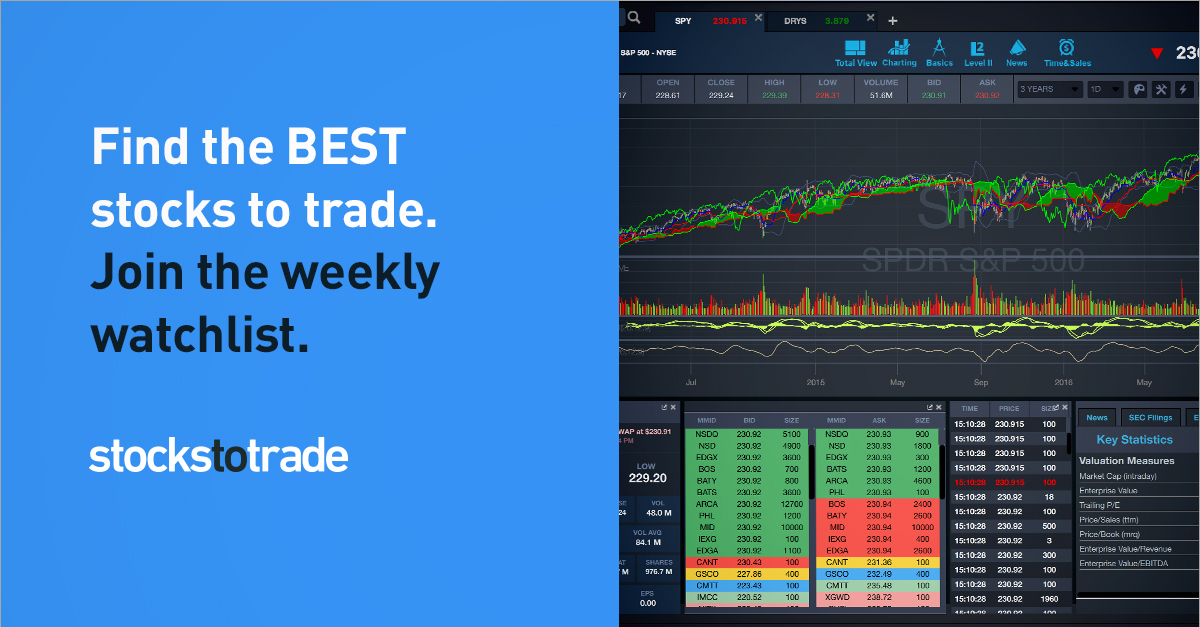If you study with me and the Steady TradeTeam, you might hear me talk about real stocks versus junk stocks…
When you trade, one big decision you have to make which types of stocks you’ll trade.
Not every stock traded on the stock market is a respectable company like Google or General Electric…
In fact, there are plenty of junk stocks and outright sketchy, shady companies. But surprisingly, these can often be some of the biggest and fastest-moving stocks. Some can move 10%, 20%, or more in a single session.
 In this post, I’ll break down the difference between real stocks and junk stocks and give you handy pointers for trading junk stocks.
In this post, I’ll break down the difference between real stocks and junk stocks and give you handy pointers for trading junk stocks.
Let’s get to it…
Table of Contents
Real Stocks, Junk Stocks — What’s It All Mean?
While there are thousands of stocks actively traded in the U.S. every day, by no means are they all equal.
The companies behind these stocks range from respectable blue-chips to fly-by-night junk. Look closely at some of these junkers and you may be surprised they even exist.
As a rule of thumb, a real stock has a respectable business model, a real product, a broad customer base, revenue, assets, and likely some profits.
A junk stock won’t have much in the way of services, products, assets, or revenue. Instead, they’ll probably have a shady CEO, a confusing product, and a low stock price.
So are real stocks better? Not necessarily…
It’s all about what you know and how you trade. If you know what can make stocks move, if you understand charts and chart patterns … you can set up a trading plan. You can figure out where to enter and exit trades … And you can find some amazing trading setups in junk stocks.
A Hypothetical Real Stock
Let’s get into some examples. Imagine there’s a company called REAL Corporation. Say it’s been trading on the Nasdaq since 1995 and is one of the world’s most well-known tech firms.
The company develops web-based software for consumers and businesses. Just about everyone in the world knows the company. It makes $100 billion a year in revenue, is profitable every year, and pays a handy 4% dividend to shareholders. Long-term investors love holding this stock.
The company’s management is made up of tech industry veterans and genius billionaire founders. All these people have invested heavily in the company…
It’s covered by the research department at every major investment bank, and there’s a thorough ‘investor section’ on the company’s website.
When you look through the major shareholders of the company, you see a who’s who of billionaires, hedge funds, and prominent investors.
The stock price generally won’t move more than 1 or 2% in normal, less volatile market environments. It slowly grinds up over long periods of time as you’d expect a major tech stock to do. Now, let’s compare that to…
A Hypothetical Junk Stock
Next, let’s imagine a company called JUNK Corporation. It’s headquartered out of a small strip mall in rural Ohio. If you try to call the main office phone number, no one picks up.
JUNK Corporation claims to make a product that helps boost the horsepower in your car or truck. Customers supposedly can do so by placing a box of crystals somewhere in their car.
Have these claims of increased horsepower ever been proven? Absolutely not. The website’s full of jargon that sorta sounds cool but really has no meaning.
The horsepower crystals aren’t this company’s first product. When the company was listed three years ago, it was trying to become the largest marijuana dispensary chain in Nebraska.
If you research the CEO enough, you’ll find he has a few DUIs in his history and was managing a fast food restaurant just four years ago. And this CEO makes a $200,000 salary.
 JUNK has minimal revenue, a ton of high-interest debt, and few assets on its balance sheet.
JUNK has minimal revenue, a ton of high-interest debt, and few assets on its balance sheet.
Its share price is under 10 cents, but you’ve seen the stock spike up to 40 cents twice in the past year … Then it collapses down to 10 cents again. You suspect the company hired a firm to spread rumors on the internet to cause a price spike.
Again both these examples are purely hypothetical .. And maybe I’m going a little overboard to make a point. Junk stocks aren’t necessarily as bad as this example. But there are some truly bad companies out there.
The important thing to understand is that just because a company is publicly traded, that doesn’t mean it’s a respectable company run by trustworthy people.
Real Stocks vs. Junk Stocks: How Do You Choose?
Short answer: It’s all about your strategy. Ask any trader and you’ll get a different answer on whether real stocks or junks stocks are better for day trading.
You have to consider your trading style, time frame, and risk management.
For example, if you prefer holding stocks long term, you probably want to look for respectable companies with solid financials. With that in mind, you might lean toward investing in a real stock.
But, if you’re an active trader looking for intraday plays, you might gravitate toward penny stocks. And a lot of penny stocks and low-priced stocks fall in the junk stock category.
Tips for Trading Junk Stocks
At this point, you’re probably realizing you don’t want to invest all your funds in a junk stock. But you may be looking for ways to grow a small account with some big-moving junk stocks.
Here are five on-point tips to help you trade junk stocks intelligently…
#1 Watch for News Catalysts
If you watch junk stock prices, most of the time things will be pretty boring…
Until one day a news catalyst drops — and sends the stock price rocketing up.
What’s are news catalysts? Things like media coverage, company announcements, SEC filings, or even gossip on social media.
They’re any information that excites traders and investors about a stock, causing them to buy or sell and ultimately push the price up or down.
A lot of major price moves in junk stocks come right after a news catalyst. So it’s useful to keep an eye on the latest news headlines for penny stocks. That’s a lot of work though…
An easier way to keep on top of the latest news is to sign up for the Breaking News Chat Room inside of StocksToTrade. Our team of stock market pros will alert you to the hottest news stories as soon as they occur…
#2 Check the Trading Volume and Liquidity
When you try to trade a stock like Google (NASDAQ: GOOG), it’s pretty easy to get in or out of the stock. If you want to buy or sell, there are traders sitting on the bid or ask, ready to trade.
That’s not always the case with junk stocks. At the smallest end of the market, many stocks barely trade any shares for days at a time.
This means that you could be waiting for days or even weeks to enter or exit a stock. Before you even think about entering a stock trade, make sure to check that enough volume is traded in the stock each day.
It’s also smart to use a trading volume filter in your stock scans, so you’re almost never looking at stocks that aren’t worth your time.
#3 Trade Using Chart Patterns
To be a consistent trader, you need some kind of framework for making trading decisions.
Some traders use company fundamentals, earnings, assets, and other factors. Unfortunately, junk stocks almost never have anything useful to analyze in the way of fundamentals.
That leaves you with the option of trading the price action.
The most common way to analyze a stock’s price action is to look at its chart for specific patterns.
Many traders use stock charts to determine price trends, key trading levels, entries, stop losses, and so much more.
There are countless chart patterns out there — but you don’t need to learn them all. In fact, you only really need to learn a single pattern that works for you.
Want to learn more about chart patterns? Check out this post.
#4 Watch the Level 2 Quotes
Before trading on a computer or online was a reality, traders used to stand in the trading pits all day shouting out buy and sell orders for stocks. You’ve probably seen that in movies or TV shows…
That kind of environment doesn’t exist anymore. But there is a way you can witness the raw buying and selling of junk stocks and real stocks…
That’s on the Level 2 quote screen. This is on your trading platform and it holds all the bids and asks for a stock. You can watch throughout the trading session as traders pop bid or ask orders into the market. Kinda like how old-school traders would sell buy or sell.
Watching Level 2 can also help you time your trades. It’s another glimpse into how a stock might move next.
Not all trading platforms offer Level 2 quotes … It’s something you’re more likely to find on a professional trading platform like StocksToTrade.
#5 Keep a Watchlist of Junk Stocks
There are a lot of junk stocks out there. As a smart trader, you only want to trade the ones with solid price action and the potential for big moves.
That’s why you need a watchlist. You can track junk stocks ready to break out … Before the market open each morning, you can check for movement or a news catalyst.
A watchlist is just a collection of stocks that you group by certain criteria. Many traders use several watchlists — pot stocks, biotechs, virus plays, work-from-home tickers, and so on.
You can keep your watchlist by hand (the tedious way) … or you can use StocksToTrade and maintain unlimited watchlists. Sign up for my no-cost weekly watchlist here.
 Use StocksToTrade to Trade Junk Stocks, Real Stocks, and Everything in Between
Use StocksToTrade to Trade Junk Stocks, Real Stocks, and Everything in Between
Before you even consider entering a trade, what’s smart to have on hand? Tools to help you navigate and survive in the markets.
Charts, scanners, watchlists, news feeds, and more. You need tools that can help you find, make, and manage the best trading setups for your strategy.
What’s a streamlined solution that can help you find trading opportunities that suit you? StocksToTrade — our all-in-one trading and analysis platform designed by traders for traders.
Our platform is used by some of the world’s best traders every trading day, and that’s no mistake.
Find out why for yourself: grab a 14-day trial of StocksToTrade for just $7. Or get a trial of STT with the Breaking News chat feature so you can see it in action. Learn more about the Breaking News feature here.
Conclusion
Many of the world’s greatest companies are traded on the stock market, right along with junk stocks.
Google, Apple, Coca-Cola — these longstanding businesses have done well for their shareholders over the years.
But there are also plenty of crap companies trading on the market. These are the junk stocks with shady and sometimes bizarre businesses.
The great thing? When junk stocks start moving, they can offer killer trading setups. And they can be great for traders trying to grow a small account.
This post has five key pointers to help get you started trading junk stocks. Ready for even more trading knowledge? Come and see how we look for solid trade setups every day inside the SteadyTrade Team community…
What do you think is the weirdest, shadiest junk stock trading today? Share your pick below!
